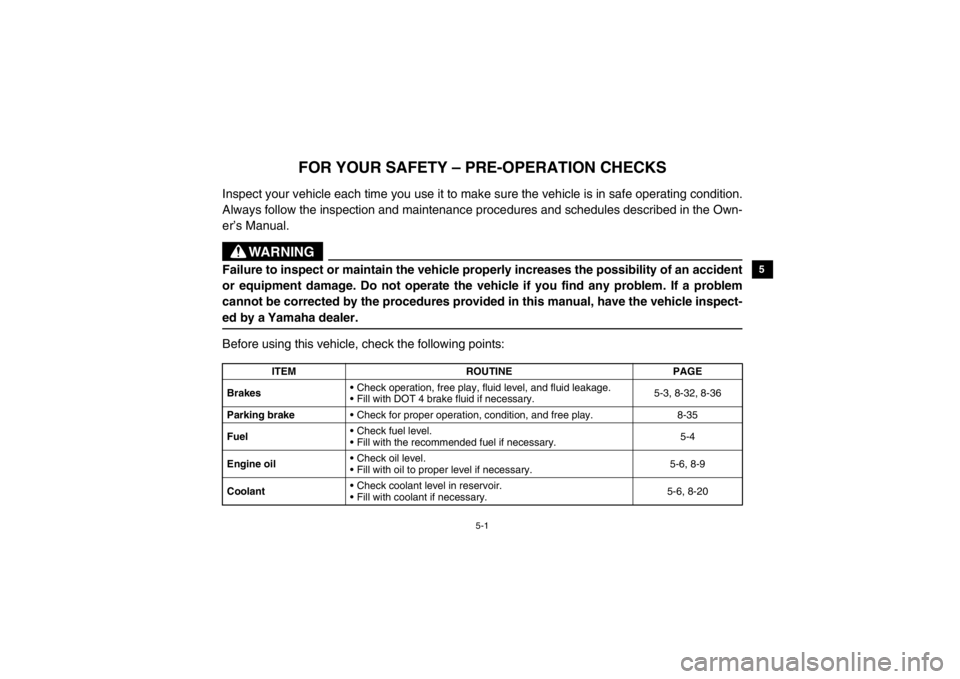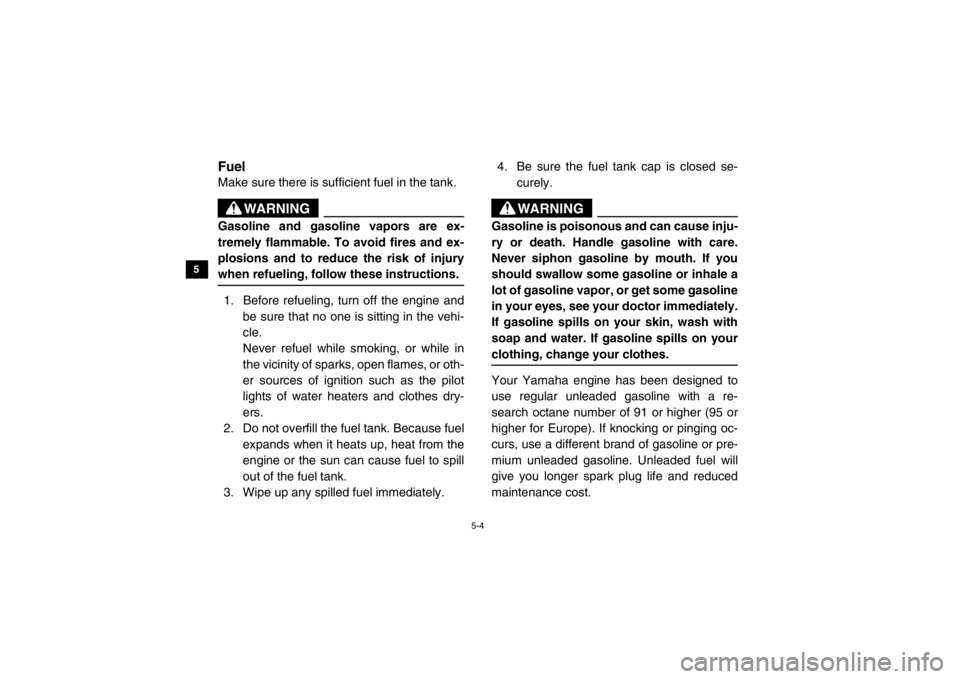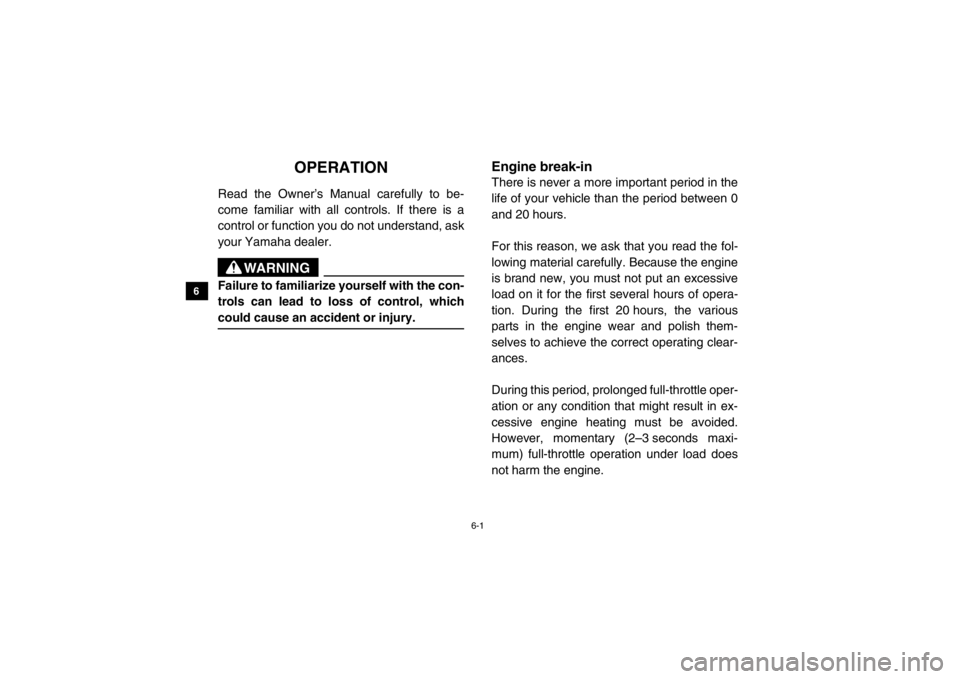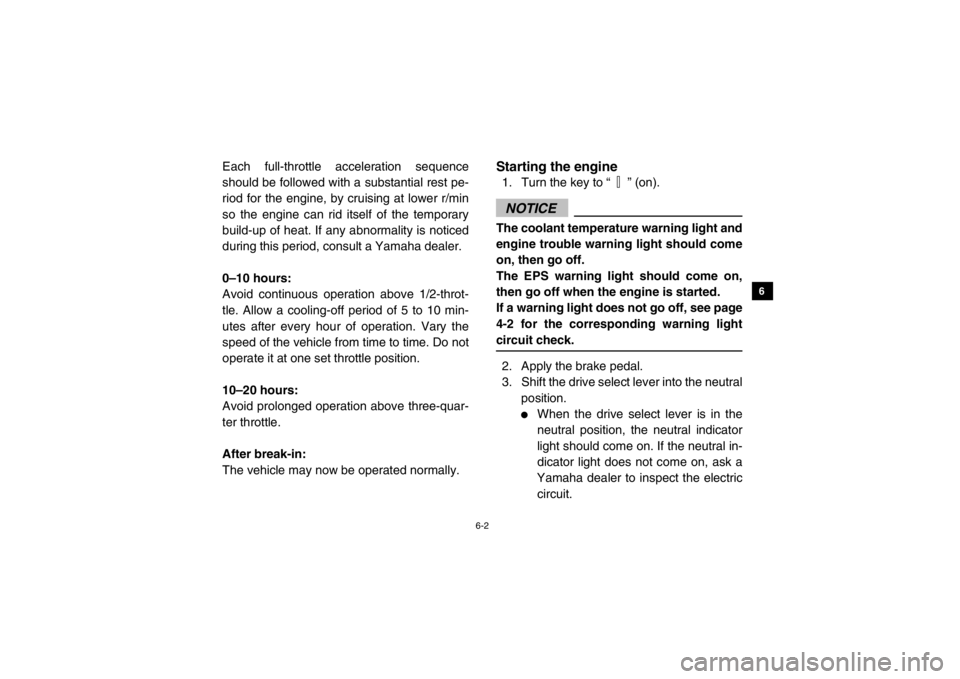Page 63 of 180

5-1
1
2
3
45
6
7
8
9
10
11
12
13
14
EVU01200
1-FOR YOUR SAFETY – PRE-OPERATION CHECKS
Inspect your vehicle each time you use it to make sure the vehicle is in safe operating condition.
Always follow the inspection and maintenance procedures and schedules described in the Own-
er’s Manual.
WARNING
Failure to inspect or maintain the vehicle properly increases the possibility of an accident
or equipment damage. Do not operate the vehicle if you find any problem. If a problem
cannot be corrected by the procedures provided in this manual, have the vehicle inspect-
ed by a Yamaha dealer.Before using this vehicle, check the following points:
ITEMROUTINE PAGE
Brakes Check operation, free play, fluid level, and fluid leakage.
Fill with DOT 4 brake fluid if necessary. 5-3, 8-32, 8-36
Parking brake Check for proper operation, condition, and free play. 8-35
Fuel Check fuel level.
Fill with the recommended fuel if necessary. 5-4
Engine oil Check oil level.
Fill with oil to proper level if necessary. 5-6, 8-9
Coolant Check coolant level in reservoir.
Fill with coolant if necessary. 5-6, 8-20
1XP7B_EE.book Page 1 Tuesday, February 4, 2014 3:40 PM
Page 66 of 180

5-4
5
6
7
8
9
10
11
12
13
14
EVU00400FuelMake sure there is sufficient fuel in the tank.
WARNING
Gasoline and gasoline vapors are ex-
tremely flammable. To avoid fires and ex-
plosions and to reduce the risk of injury
when refueling, follow these instructions.1. Before refueling, turn off the engine and be sure that no one is sitting in the vehi-
cle.
Never refuel while smoking, or while in
the vicinity of sparks, open flames, or oth-
er sources of ignition such as the pilot
lights of water heaters and clothes dry-
ers.
2. Do not overfill the fuel tank. Because fuel
expands when it heats up, heat from the
engine or the sun can cause fuel to spill
out of the fuel tank.
3. Wipe up any spilled fuel immediately. 4. Be sure the fuel tank cap is closed se-
curely.
WARNING
Gasoline is poisonous and can cause inju-
ry or death. Handle gasoline with care.
Never siphon gasoline by mouth. If you
should swallow some gasoline or inhale a
lot of gasoline vapor, or get some gasoline
in your eyes, see your doctor immediately.
If gasoline spills on your skin, wash with
soap and water. If gasoline spills on your
clothing, change your clothes.Your Yamaha engine has been designed to
use regular unleaded gasoline with a re-
search octane number of 91 or higher (95 or
higher for Europe). If knocking or pinging oc-
curs, use a different brand of gasoline or pre-
mium unleaded gasoline. Unleaded fuel will
give you longer spark plug life and reduced
maintenance cost.
1XP7B_EE.book Page 4 Tuesday, February 4, 2014 3:40 PM
Page 68 of 180

5-6
5
6
7
8
9
10
11
12
13
14
EVU00410Engine oilMake sure the engine oil is at the specified
level. Add oil as necessary. (See page 8-9.)NOTICE●
In order to prevent clutch slippage
(since the engine oil also lubricates
the clutch), do not mix any chemical
additives with oil. Do not use oils with
a diesel specification of “CD” or oils
of a higher quality than specified. In
addition, do not use oils labeled “EN-
ERGY CONSERVING II” or higher.
●
Make sure that no foreign material en-
ters the crankcase.
EVU00420CoolantCheck the coolant level in the coolant reser-
voir when the engine is cold (the coolant level
will vary with engine temperature).
The coolant level is satisfactory if it is between
the minimum and maximum level marks on
the coolant reservoir. If the coolant level is at
or below the minimum level mark, add addi-
tional coolant to bring the level up to maxi-
mum level mark. If coolant is not available,
add distilled water. Change the coolant every
two years. (See page 8-20 for details.)NOTICEHard water or salt water is harmful to the
engine. You may use soft water if you can-
not get distilled water.
Recommended engine oil type and
quantity: See page 10-1.
Coolant reservoir capacity
(up to the maximum level mark):0.28 L (0.30 US qt, 0.25 Imp.qt)
1XP7B_EE.book Page 6 Tuesday, February 4, 2014 3:40 PM
Page 74 of 180

6-1
6
7
8
9
10
11
12
13
14
EVU00530
1-OPERATION
Read the Owner’s Manual carefully to be-
come familiar with all controls. If there is a
control or function you do not understand, ask
your Yamaha dealer.
WARNING
Failure to familiarize yourself with the con-
trols can lead to loss of control, which
could cause an accident or injury.
Engine break-inThere is never a more important period in the
life of your vehicle than the period between 0
and 20 hours.
For this reason, we ask that you read the fol-
lowing material carefully. Because the engine
is brand new, you must not put an excessive
load on it for the first several hours of opera-
tion. During the first 20 hours, the various
parts in the engine wear and polish them-
selves to achieve the correct operating clear-
ances.
During this period, prolonged full-throttle oper-
ation or any condition that might result in ex-
cessive engine heating must be avoided.
However, momentary (2–3 seconds maxi-
mum) full-throttle operation under load does
not harm the engine.
1XP7B_EE.book Page 1 Tuesday, February 4, 2014 3:40 PM
Page 75 of 180

6-2
1
2
3
4
56
7
8
9
10
11
12
13
14
Each full-throttle acceleration sequence
should be followed with a substantial rest pe-
riod for the engine, by cruising at lower r/min
so the engine can rid itself of the temporary
build-up of heat. If any abnormality is noticed
during this period, consult a Yamaha dealer.
0–10 hours:
Avoid continuous operation above 1/2-throt-
tle. Allow a cooling-off period of 5 to 10 min-
utes after every hour of operation. Vary the
speed of the vehicle from time to time. Do not
operate it at one set throttle position.
10–20 hours:
Avoid prolonged operation above three-quar-
ter throttle.
After break-in:
The vehicle may now be operated normally.
5B410007Starting the engine1. Turn the key to “ ” (on).NOTICEThe coolant temperature warning light and
engine trouble warning light should come
on, then go off.
The EPS warning light should come on,
then go off when the engine is started.
If a warning light does not go off, see page
4-2 for the corresponding warning light
circuit check.2. Apply the brake pedal.
3. Shift the drive select lever into the neutralposition.
●
When the drive select lever is in the
neutral position, the neutral indicator
light should come on. If the neutral in-
dicator light does not come on, ask a
Yamaha dealer to inspect the electric circuit.
1XP7B_EE.book Page 2 Tuesday, February 4, 2014 3:40 PM
Page 76 of 180
6-3
6
7
8
9
10
11
12
13
14
●
The engine can be started in any gear
if the brake pedal is applied. However,
it is recommended to shift into neutral
before starting the engine.
4. With your foot off the accelerator pedal, start the engine by turning the key to “ ”
(start).
If the engine fails to start, release the key, and
then try starting it again. Wait a few seconds
before the next attempt. Each attempt should
be as short as possible, to preserve battery
energy. NOTICE: Do not crank the engine
more than 5 seconds on each attempt, or
starter damage could occur. Wait at least 5
seconds between each operation of the
electric starter to let it cool.
Do not turn the key to the “ ” (start) position
with the engine running; otherwise, damage
to the electric starter may result.
TIPFor maximum engine life, never accelerate
hard when the engine is cold!
1XP7B_EE.book Page 3 Tuesday, February 4, 2014 3:40 PM
Page 77 of 180
6-4
1
2
3
4
56
7
8
9
10
11
12
13
14
Drive select lever operation and
reverse drivingNOTICEDo not shift without coming to a complete
stop and waiting for the engine to return to
normal idle speed. Damage to the engine
or drive train may occur.Shifting: neutral to high and high to low
1. Stop the vehicle, and take your foot off
the accelerator pedal. 2. Apply the brake pedal, then shift by mov-
ing the drive select lever along the shift
guide. Make sure that the drive select le-
ver is completely shifted into position.
1. Drive select lever 2. L (Low-range)
3. H (High-range) 4. N (Neutral)
5. R (Reverse)3. Release the parking brake, if applied.
4. Release the brake pedal and press the
accelerator pedal gradually.
1
2
5 4
3
1XP7B_EE.book Page 4 Tuesday, February 4, 2014 3:40 PM
Page 78 of 180

6-5
6
7
8
9
10
11
12
13
14
Shifting: neutral to reverse
WARNING
Before you shift into reverse, make sure
there are no obstacles or people behind
you. When it is safe to proceed, go slowly.
Hitting an obstacle or person could result
in serious injury or death.1. Stop the vehicle, take your foot off the ac- celerator pedal, and check behind you.
2. Apply the brake pedal.
3. Shift from neutral to reverse or vice versa
by moving the drive select lever along the
shift guide.
●
When in reverse, the reverse indicator
light should be on. If the light does not
come on, ask a Yamaha dealer to in-
spect the reverse indicator light elec-
trical circuit.
●
Due to the synchronizing mechanism
in the engine, the light may not come
on until the vehicle starts moving.
1. Drive select lever 2. L (Low-range)
3. H (High-range) 4. N (Neutral)
5. R (Reverse)4. Release the parking brake, if applied.
5. Check behind the vehicle for people or obstacles, and then release the brake
pedal.
6. Press the accelerator pedal gradually and continue to watch to the rear while
backing.
1
2
5 4
3
1XP7B_EE.book Page 5 Tuesday, February 4, 2014 3:40 PM